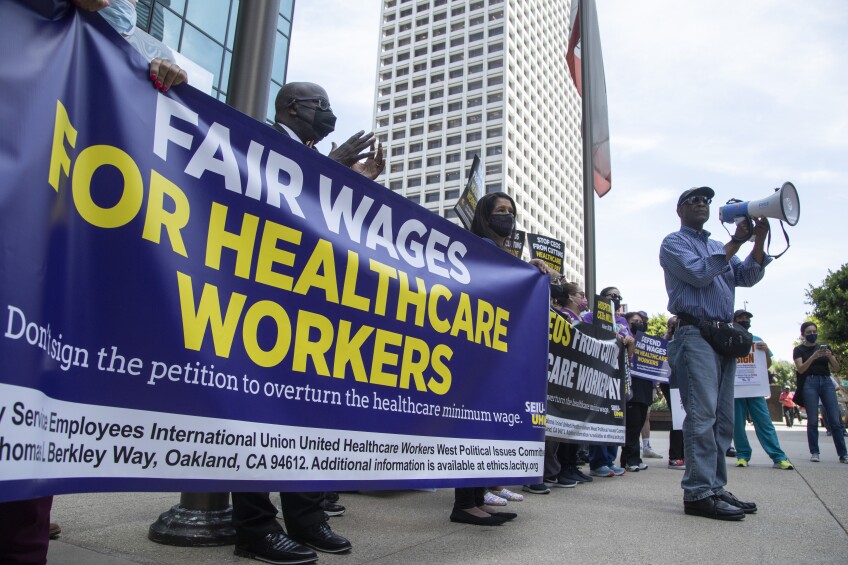Ballot Measures: People-Powered Policy-Making? Or A Way for Wealthy Interests to Exert Influence?

This article was produced with UT Community News, which is produced by Cal State L.A. journalism students and covers public issues on the Eastside and South L.A.
There were 11 statewide propositions in the 2018 midterm election and 12 in the 2020 presidential election — and there are seven on the ballot in the November general election.
Why are there so many ballot measures in California during midterm and presidential election cycles, and how do they get on the ballot in the first place?
Here are the steps involved with getting propositions on the ballot, according to the Californiasecretary of state and attorney general's websites:
- Draft the proposal: Any initiative petition begins with writing a proposal draft, also known as the initial draft.
- Submit draft: The draft is submitted to the attorney general with a filing fee of $2,000, which is refunded if the proposal makes it onto the ballot.
- Collect signatures: Organizers can use volunteers or paid workers to collect citizen signatures on the initiative petition.
- Allow for verification: Election officials verify that the signatures are from California residents who are citizens and registered to vote.
After that, the secretary of state determines whether the initiative qualifies for the ballot or not.
Creating a process by which California residents can add propositions to the ballot through initiative petitions — to let real people power policies — allows for "direct democracy."
After all, elected officials — like legislators and the governor — might be influenced by campaign contributions from powerful special interests or lobbyists.
You can get a lot of things on the ballot if you have enough money because you can hire people to get those signatures.Dr. Raphael J. Sonenshein, executive director of the Pat Brown Institute at Cal State LA
However, those same wealthy or powerful people and groups could also influence whether propositions make it to the ballot, according to Dr. Raphael J. Sonenshein, executive director of the Pat Brown Institute at Cal State LA.
"You can get a lot of things on the ballot if you have enough money because you can hire people to get those signatures," said Sonenshein. But, he added, "The voters don't always know who's paying for these things."

But a signature on a petition doesn't always mean support for actually passing the proposition, Sonenshein explained. "Sometimes, they are more likely to sign something to put it on the ballot, knowing they still get to vote," he said. "They might turn around and vote 'no' on it."
That also means that an issue that may be actually supported by voters may fail because of the lack of funds needed to collect enough signatures.
A recent example of a failed initiative campaign is one that would have prohibited fracking and phased out the use of the oil, natural gas and coal.
According to aPPIC survey, 61% of voters support the banning of fracking permits, a plan introduced by Governor Gavin Newsom. But the petition was officially withdrawn in June after it failed to collect the required 623,212 signatures.
Pass ... Or Fail?
If a proposed ballot measure is verified, supporters and opponents typically start raising awareness in an attempt to convince voters of its merits or flaws — and that's the second time in the process that money can influence outcomes.

"Some of [the ballot initiatives] aren't getting a lot of publicity behind them because there's not a lot of money on either side. And yet, they're very important," Sonenshein said.
For example, a 2021 proposed initiative known as the Elijah McClain Police Accountability Act would have introduced consequences for police officers using excessive force against the public, but it failed to make it onto the ballot.
Other times, the funding on one side far outweighs the other.
According to state data compiled by Ballotpedia, supporters of Prop 31, a state proposition on the November ballot that would uphold the state's ban on flavored tobacco products, raised more than $6 million; while those opposing it, including tobacco companies, raised more than $22 million. (See below.)
Proposition 26, which would legalize sports betting at Native American casinos if it passed this November, is on the ballot alongside Proposition 27, which would legalize online sports betting.
Prop 26 vs. Prop 27
Prop 26 is being funded by Native American tribes, which stand to benefit from the addition of sports betting to their casinos, whereas Prop 27 is being primarily funded by online gambling companies. A list of donors can be found on the secretary of state's website.
Prop 26:
Prop 27:
However, there is good news for those who really believe in a proposition: They can also organize grassroots campaigns, using social media, community forums and other spaces to rally enough support to pass the ballot measure.
In 2012, Proposition 30, which increased taxes in the state to fund public schools, saw the support of many women and teachers groups. The measure passed with 55.37% of votes.
Election Day is Tuesday, November 8, 2022.













